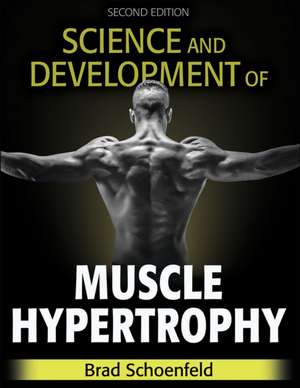Science and Development of Muscle Hypertrophy
Autor Brad J. Schoenfelden Limba Engleză Hardback – 19 apr 2020
This new edition offers more than 1,000 references and applied guidelines. Two all-new chapters deliver practical content on the measurement of muscle hypertrophy and advanced training practices. Readers will learn various methods by which hypertrophy is measured, including site-specific measures (circumference measures, MRI, CT, and ultrasound), indirect measures (underwater weighing, DXA, BIA, ADP, and skinfolds), and histological measures (biopsy), as well as the strengths and limitations of each modality. The new edition also provides guidance for achieving greater training volumes with training practices that maximize the individual's genetic potential to gain muscle.
No other resource offers a comparable amount of content solely focused on the science of muscle hypertrophy and its application to designing training programs. The full-color book offers several features to make the content accessible to readers:
- Research Findings sidebars highlight the aspects of muscle hypertrophy currently being examined to encourage readers to re-evaluate their knowledge and ensure their training practices are up to date.
- Practical Applications sidebars outline how to apply the research conclusions for maximal hypertrophic development.
- Comprehensive subject and author indexes optimize the book's use as a reference tool.
Science and Development of Muscle Hypertrophyis an invaluable resource for those seeking to maximize hypertrophic gains for themselves or their athletes or clients and for those searching for the most comprehensive and authoritative research in the field.
Preț: 369.84 lei
Preț vechi: 456.59 lei
-19% Nou
70.77€ • 74.09$ • 58.56£
Carte disponibilă
Livrare economică 17-31 martie
Livrare express 01-07 martie pentru 59.43 lei
Specificații
ISBN-10: 1492597678
Pagini: 312
Dimensiuni: 220 x 286 x 23 mm
Greutate: 1.27 kg
Ediția:2 ed
Editura: MG – Human Kinetics
Descriere
Science and Development of Muscle Hypertrophy, Second Edition, is the most comprehensive resource on muscle hypertrophy in the world. Written by Brad Schoenfeld, PhD, an internationally renowned expert on muscle hypertrophy, this book is the definitive resource for strength and conditioning professionals, personal trainers, sport scientists, researchers, and exercise science instructors who are seeking information regarding muscle hypertrophy, including the mechanism of its development, how the body structurally and hormonally changes when exposed to stress, ways to most effectively design training programs, and nutritional guidelines for eliciting hypertrophic changes.
This new edition offers more than 1,000 references and applied guidelines. Two all-new chapters deliver practical content on the measurement of muscle hypertrophy and advanced training practices. Readers will learn various methods by which hypertrophy is measured, including site-specific measures (circumference measures, MRI, CT, and ultrasound), indirect measures (underwater weighing, DXA, BIA, ADP, and skinfolds), and histological measures (biopsy), as well as the strengths and limitations of each modality. The new edition also provides guidance for achieving greater training volumes with training practices that maximize the individual's genetic potential to gain muscle.
No other resource offers a comparable amount of content solely focused on the science of muscle hypertrophy and its application to designing training programs. The full-color book offers several features to make the content accessible to readers:
- Research Findings sidebars highlight the aspects of muscle hypertrophy currently being examined to encourage readers to re-evaluate their knowledge and ensure their training practices are up to date.
- Practical Applications sidebars outline how to apply the research conclusions for maximal hypertrophic development.
- Comprehensive subject and author indexes optimize the book's use as a reference tool.
Although muscle hypertrophy can be attained through a range of training programs, this book allows readers to understand and apply the specific responses and mechanisms that promote optimal muscle hypertrophy. It explores how genetic background, age, sex, and other factors have been shown to mediate the hypertrophic response to exercise, affecting both the rate and the total gain in lean muscle mass. Sample programs show how to design a three- or four-day-per-week undulating periodized program and a modified linear periodized program for maximizing muscular development.
Science and Development of Muscle Hypertrophy is an invaluable resource for those seeking to maximize hypertrophic gains for themselves or their athletes or clients and for those searching for the most comprehensive and authoritative research in the field.
Cuprins
Neuromuscular System
Endocrine, Paracrine, and Autocrine Systems
Chapter 2. Mechanisms of Hypertrophy
Mechanical Tension
Metabolic Stress
Muscle Damage
Chapter 3. The Measurement of Muscle Hypertrophy
Indirect Measures
Site-Specific Measures
Chapter 4. Role of Resistance Training Variables in Hypertrophy
Volume
Frequency
Load
Exercise Selection
Type of Muscle Action
Rest Interval Length
Repetition Duration
Exercise Order
Range of Motion
Intensity of Effort
Chapter 5. Advanced Training Practices
Loaded Stretch Training
Intraset Rest Training
Drop Sets
Supersets and Pre-exhaustion
Eccentric Overload Training
Chapter 6. Role of Aerobic Training in Hypertrophy
Hypertrophic Effects From Aerobic-Only Training
Concurrent Training
Chapter 7. Factors in Maximal Hypertrophic Development
Genetics
Age
Sex
Training Status
Chapter 8. Program Design for Maximal Hypertrophy
Biomechanics
Exercise Selection Strategies
Periodization
Chapter 9. Nutrition for Hypertrophy
Energy Balance
Macronutrient Intake
Feeding Frequency
Nutrient Timing
Notă biografică
Schoenfeld is the recipient of the 2016 Dwight D. Eisenhower Fitness Award, which is presented by the United States Sports Academy for outstanding achievement in fitness and contributions to the growth and development of sport fitness through outstanding leadership activity. He was also the 2018 cowinner of the NSCA Outstanding Young Investigator award. He is the author of multiple fitness books, including The M.A.X. Muscle Plan and Strong & Sculpted. He has been published or featured in virtually every major fitness magazine and has appeared on hundreds of television shows and radio programs across the United States. Currently, he writes the “Ask the Muscle Doc” column for Bodybuilding.com.
Schoenfeld earned his PhD in health promotion and wellness at Rocky Mountain University, where his research focused on elucidating the mechanisms of muscle hypertrophy and their application to resistance training. He has published more than 200 peer-reviewed scientific papers and serves on the editorial advisory boards for several journals, including the Journal of Strength and Conditioning Research and the Journal of the International Society of Sports Nutrition.
Schoenfeld is an associate professor of exercise science at Lehman College in the Bronx, New York, and is director of the graduate program in human performance and fitness. He also serves as a sports nutrition consultant for the New Jersey Devils hockey organization.


























